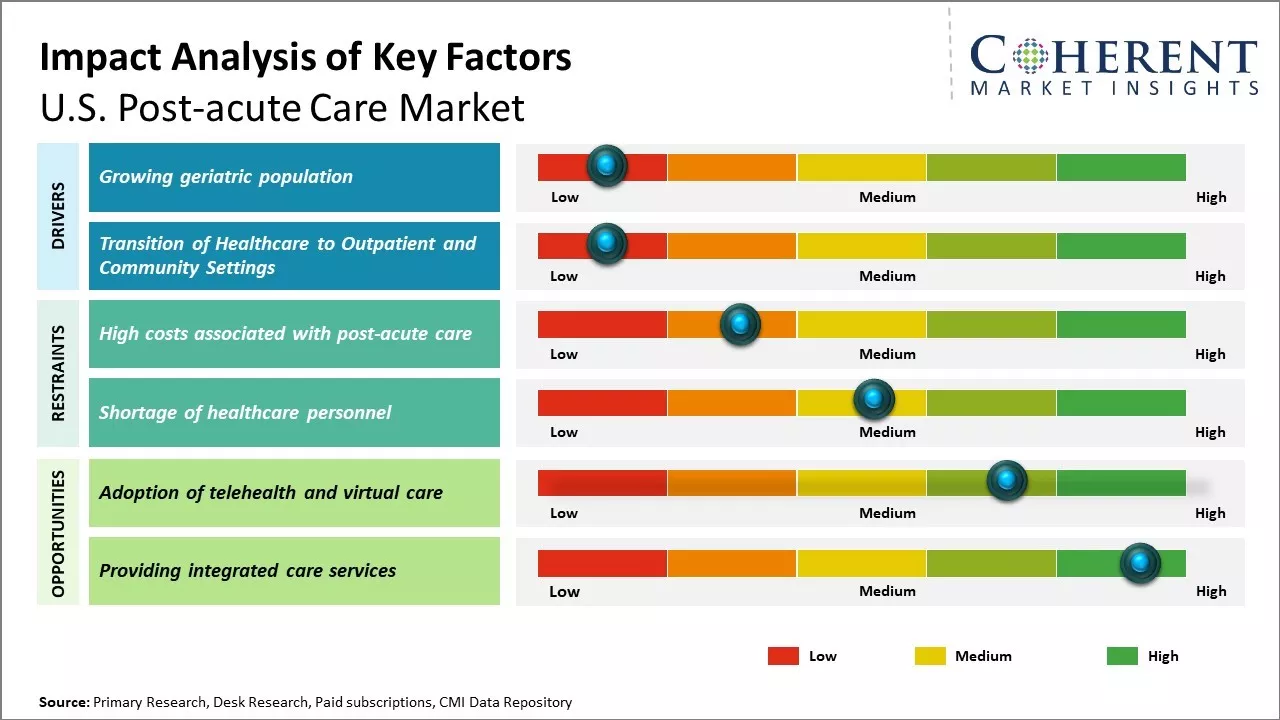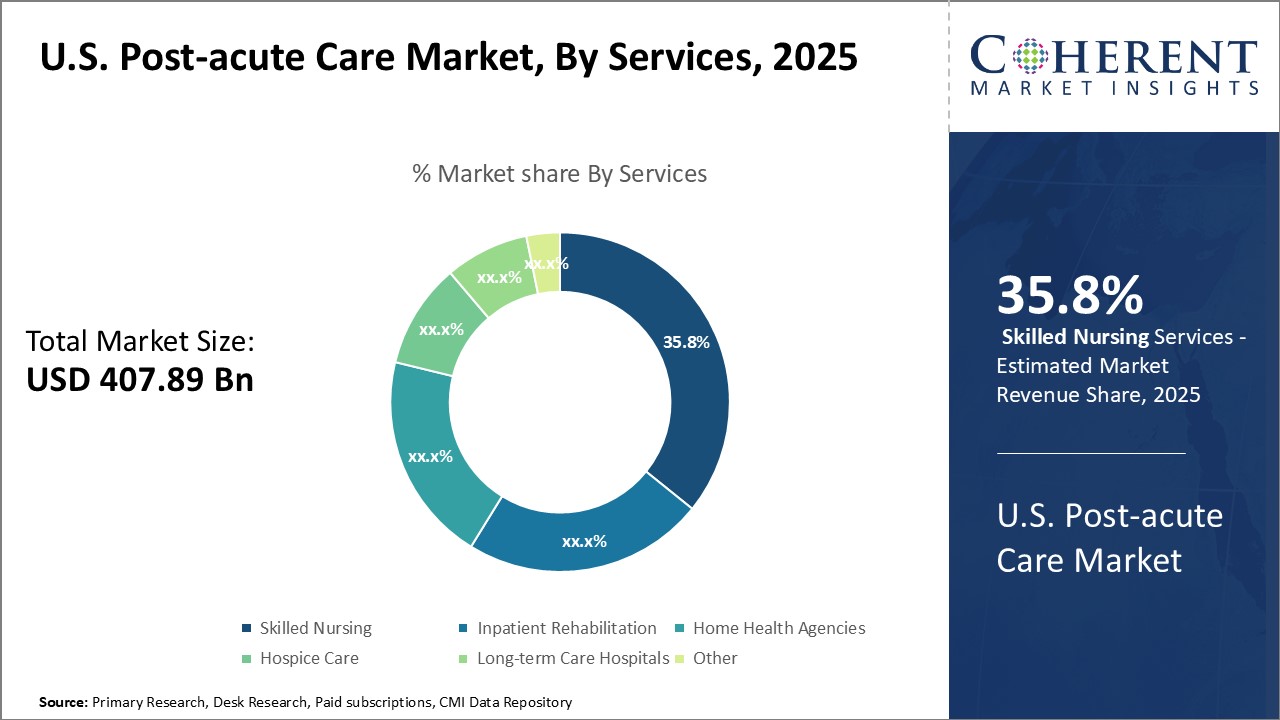U.S. Post-acute Care Market Size and Trends
U.S. post-acute care market is estimated to be valued at USD 407.89 Bn in 2025 and is expected to reach USD 668.37 Bn by 2032, exhibiting a compound annual growth rate (CAGR) of 7.3% from 2025 to 2032.

Discover market dynamics shaping the industry: Download Free Sample
The market is witnessing steady growth due to rising geriatric population in the U.S. As per estimates, population aged 65 years and above is expected to double from 52 million to around 95 million by 2060. Older adults often require post-acute care services such as skilled nursing facilities, inpatient rehabilitation facilities, long-term care hospitals and home health care for recuperating after illnesses or surgery. With growth in elder demographics, there will be huge demand for post-acute care services. Increased accessibility of these services, along with provision of better health benefits from public and private insurers, can drive the U.S. post-acute care market growth.
Growing geriatric population
Growth in the post-acute care market in the United States may be fueled by the aging population, or individuals 65 and over. More and more senior Americans will need post-hospitalization care as baby boomers continue to reach retirement age. The number of Americans 65 and older is predicted to rise from 57 million in 2019 to over 88 million by 2050, more than doubling their proportion of the country's total population from 16% to over 20%, according to figures released by the U.S. Census Bureau. People's ability to live independently declines with age, and they are more prone to experience long-term health issues, functional restrictions, and even transient disability from diseases or accidents that call for assistance or rehabilitation. Post-acute care serves as an important middle ground between full recovery at home or the need for long-term nursing home care, through options like skilled nursing facilities, inpatient rehabilitation facilities, long-term care hospitals and home health agencies. Growing aging population can boosts demand for convalescent services as well as management and support of lingering or worsening health issues. For instance, in October 2022, according to the data from the World Health Organization, the number of adults aged 60 years worldwide is expected to more than double, from less than 1 billion in 2020 to around 2.1 billion by 2050 due to continued increase in life expectancy. The WHO has also found chronic conditions to be the leading cause of disability, and this boosts demand for long-term, post-hospitalization care. As life expectancies lengthen on a global scale, more healthcare systems will face resource challenges in caring for their growing senior populations. The American post-acute care sector is still in its relatively early stages of accommodating these demographic trends but already finds itself responding to escalating needs.
Market Concentration and Competitive Landscape

Get actionable strategies to beat competition: Download Free Sample
Transition of healthcare to outpatient and community settings
Transition, occurring in the overall healthcare system, from traditional inpatient hospital stays to greater emphasis on outpatient services and keeping care in community settings can drive the market growth. Pressures to reduce hospital readmission rates, shorten average patient stay in hospitals, controlling escalating healthcare costs, and patient preferences to receive care in more comfortable and familiar surroundings can drive the market growth. Post-acute care providers are well positioned to play an important role in this transition by providing services like skilled nursing, therapy, wound care, chronic disease management, and others in facilities located in the community instead of in acute care hospitals. This allows for a continuum of care and smoother transition from hospital to home with support services tailored to individual needs for rehabilitation or recovery. The shift towards value-based reimbursement models also creates incentives for post-acute providers to demonstrate quality outcomes and patient satisfaction in order to remain preferred partners in this restructured healthcare environment centered around delivering high quality cost-effective care.
Key Takeaways from Analyst:
The U.S. post-acute care market growth is driven by aging baby boomer population who will require long-term chronic care in the near future. This demographic shift will boost demand across different post-acute settings. Ongoing transition towards value-based care models where providers are incentivized to care for patients in the least restrictive settings can also drive the market growth. This encourages shorter hospital stays and greater utilization of skilled nursing facilities, inpatient rehabilitation facilities, and home health care.
On the provider side, the demand for skilled nursing has increased the most due to financial merits compared to other settings. However, skilled nursing industry faces challenges around quality measures and staffing shortages. The home health sector offer lucrative opportunities supported by patient preference for home-based recovery services and potential cost savings as compared to facility-based care. In the Northeast region, skilled nursing and inpatient rehabilitation markets remain essential due to high number of older adults.
Post-acute care industry remains in a period of transition as the needs of the growing senior population evolve and new payment models drive structural changes across different provider types. Consolidation activity is also underway to build scale and diversified service offerings.
Market Challenges: High costs associated with post-acute care
The high costs associated with post-acute care in the U.S. can hamper the market growth. Post-acute care refers to the care received after being discharged from a hospital, which can include skilled nursing facilities, home health agencies, inpatient rehabilitation facilities, and long-term care hospitals. While post-acute care plays an important role in the continuing recovery of patients, it also tends to be very expensive. According to the data from the Centers for Medicare and Medicaid Services, national health expenditure on post-acute care had increased from US$ 185 billion in 2012 to US$ 274 billion in 2020. This rising expenditure is primarily due to increasing utilization of post-acute care services, as well as growing demand for more intensive levels of care as patients present with more complex medical conditions. The costs of skilled nursing facilities, home health care, and inpatient rehabilitation facilities in particular have increased substantially in recent years.
Market Opportunities: Adoption of telehealth and virtual care
The COVID-19 pandemic has boosted adoption of telehealth and virtual care services in the U.S. healthcare system tremendously. With the necessity of social distancing and limiting in-person visits, both patients and providers rapidly embraced remote care alternatives. This has provided a glimpse into how telehealth can reshape post-acute care, which includes skilled nursing facilities, inpatient rehabilitation facilities, long-term care hospitals, and home health. The flexibility and convenience of virtual visits makes telehealth well-suited for managing post-acute care patients who have complex conditions and frequent need for follow-up. As patients recover from illnesses and injuries, virtual care allows providers to regularly monitor their progress without need of in-person appointments. Government organizations have also supported expanding access to telehealth amid the pandemic. The Centers for Medicare and Medicaid Services (CMS) moved to cover telehealth at parity with in-person visits on a temporary basis in 2021. This opened up telehealth to millions of Medicare beneficiaries who previously had limited access. As baby boomers age, their increased demand for post-acute services coincides with a growing openness to digital health technologies. If CMS makes permanent some of the telehealth flexibilities put in place during the pandemic, it could remove barriers preventing telehealth from becoming a standard part of post-acute care. Permanent coverage and payment policies from CMS will be vital to sustain long-term virtual care adoption.

Discover high revenue pocket segments and roadmap to it: Download Free Sample
Insights, By Services- Ageing population boosts skilled nursing segment growth
In terms of services, skilled nursing segment is estimated to contribute the highest market share of 35.3 % in 2025, due to the growing elderly population who require long-term and assisted living care. Skilled nursing facilities provide 24-hour nursing care for individuals recovering from surgery or illness and those who need assistance with daily tasks like bathing and dressing. With people aged above 65 years representing the fastest growing segment of the population, there has been huge demand for skilled nursing services. Medicare spending on skilled nursing had increased by over 35.8% in the past decade alone as more senior citizens need rehabilitation or assistance to cope with multiple chronic conditions. Facilities are focusing on specialization to meet the complex needs of an aging population with diseases like dementia. The development of nursing models that optimize staffing while improving quality of care will be crucial to address this growing demand.
Insights, By Age Group- Chronic conditions boosts spinal cord injury segment growth
In terms of age group, elderly segment is estimated to contribute the highest market share of 40.12 % in 2025, due to growing elderly population in the U.S. The proportion of Americans aged above 65 years is expected to increase to nearly 24.5% of the total population by 2060. As individuals age, they are more prone to acquiring chronic conditions, functional and cognitive impairments which often necessitate post-acute care services. The elderly people utilize home health care, skilled nursing and inpatient rehabilitation at much higher rates than other groups. Elderly people requires recuperative and long-term management of conditions like arthritis, heart disease and Alzheimer's disease. Younger generations are also keeping their parents out of nursing homes for longer, relying more on home and community-based programs. The shift to aging-in-place will compel post-acute care providers to enhance services geared for frail and older adult populations, including expanded home and primary care models.
Insights, By Conditions- Chronic conditions boosts spinal cord injury segment
In terms of conditions, spinal cord injury segment is estimated to contribute the highest market share of 30.23 % in 2025 owing to the lifelong care needs of patients. While spinal cord injury incidents have remained stable in the U.S., survival rates for individuals with SCI have improved due to advanced treatment and rehabilitation. Thus, there is a large and growing population requiring long-term management of SCI-related secondary medical complications and physical disabilities. Chronic conditions associated with SCI like urinary tract infections, pneumonia, chronic pain and pressure ulcers require specialized rehabilitation and ongoing care. The complexity of SCI patient needs and scarcity of facilities with expertise in SCI rehabilitation has boosted utilization of post-acute care settings. Increased research into disorder mechanisms and new drug therapies aim to reduce secondary complications to help curb costs and improve quality of life for those living with spinal cord injury.
Regional Insights
The United States post-acute care market continues to be dominated by the Southeast region with share of 38.2 % in 2025, States such as Florida, Texas and North Carolina have been at the forefront of boosting demand in this sector owing to their large and growing senior populations. The warm weather and low cost of living have made this region an attractive retirement destination for older Americans, necessitating a growing need for senior care services. With over 1.0% of their combined populations aged 65 and above, these states account for a significant share of national post-acute care expenditures. Industry observers also cite the business-friendly regulations and tax policies in the Southeast as encouraging higher inflows of skilled nursing facilities and rehabilitation centers catering to post-acute needs.
Meanwhile, the Western region, specifically states such as California, Washington and Colorado have emerged as the fastest growing market for post-acute services. Although these states have traditionally trailed the Southeast in terms of overall market size, robust economic growth across major metropolitan areas is attracting larger migrant populations including retirees from other regions. The migration trends have led to above average increases in the number of Americans in their late 60s and above opting to age within their families in the Western states. With its mild winters and availability of younger family support networks, the West is fast transforming into a hotspot for caregivers seeking alternatives to traditional senior living communities. Spurred by these demographic shifts, providers have also significantly stepped-up investments in a variety of outpatient, home health and assisted living settings in the Western region.
Market Report Scope
U.S. Post-acute Care Market Report Coverage
| Report Coverage | Details | ||
|---|---|---|---|
| Base Year: | 2024 | Market Size in 2025: | USD 407.89 Bn |
| Historical Data for: | 2020 To 2024 | Forecast Period: | 2025 To 2032 |
| Forecast Period 2025 to 2032 CAGR: | 7.3% | 2032 Value Projection: | USD 668.37 Bn |
| Geographies covered: |
|
||
| Segments covered: |
|
||
| Companies covered: |
Kindred Healthcare, Encompass Health Corporation , HCR ManorCare, Brookdale Senior Living, Genesis HealthCare, Amedisys, Inc., LHC Group, Inc., Select Medical Holdings Corporation, Vitas Healthcare , Post Acute Medical, LLC, SavaSeniorCare Administrative Services LLC, LifeCare Health Partners, Extendicare, Ensign Group, Inc., Sunrise Senior Living, LLC, BAYADA Home Health Care |
||
| Growth Drivers: |
|
||
| Restraints & Challenges: |
|
||
Uncover macros and micros vetted on 75+ parameters: Get instant access to report
U.S. Post-acute Care Industry News
- In May 2023, Inova, a leading nonprofit healthcare provider, and Select Medical opened a new Select Specialty Hospital at Inova Mount Vernon Hospital in Northern Virginia. It provides specialized care for critically ill patients who required extended treatment beyond acute care but no longer needed intensive care. The hospital had held a ribbon-cutting ceremony on May 16 and began admitting patients on May 23.
- In February 2024, tango and WellSky, a healthcare technology and services firms, partnered to deliver a fully integrated, post-acute care (PAC) episode management program for health plans. This partnership is focused on facilitating high-quality, end-to-end management of post-acute care, aiming to align incentives for health plans, risk-bearing entities, providers, and patients across the continuum. tango and WellSky aims to enhance provider experience, improve care quality, boost patient satisfaction, and ensure guaranteed cost savings.
*Definition: U.S. post-acute care market aim to support patients in regaining their health and independence, facilitating their transition from acute medical settings back to their homes or to less intensive care settings. This continuum of care includes various interventions such as rehabilitative therapies, skilled nursing care, medical monitoring, and assistance with activities of daily living. The goal is to optimize outcomes, prevent complications, and ensure a smooth recovery process tailored to each individual's needs.
Market Segmentation
- Services Insights (Revenue, USD Bn, 2020 - 2032)
-
- Inpatient Rehabilitation
- Skilled Nursing
- Home Health Agencies
- Hospice Care
- Long-term Care Hospitals
- Other
- Age Group Insights (Revenue, USD Bn, 2020 - 2032)
-
- Elderly
- Adult
- Child
- Conditions Insights (Revenue, USD Bn, 2020 - 2032)
-
- Wound Management
- Amputations
- Orthopedic Disorders
- Respiratory Disorders
- Spinal Cord Injury
- Neurological Disorders
- Oncology Conditions
- Others
- Key Players Insights
-
- Kindred Healthcare
- Encompass Health Corporation
- HCR ManorCare
- Brookdale Senior Living
- Genesis HealthCare
- Amedisys, Inc.
- LHC Group, Inc.
- Select Medical Holdings Corporation
- Vitas Healthcare
- Post Acute Medical, LLC
- SavaSeniorCare Administrative Services LLC
- LifeCare Health Partners
- Extendicare
- Ensign Group, Inc.
- Sunrise Senior Living, LLC
- BAYADA Home Health Care
Share
Share
About Author
Manisha Vibhute is a consultant with over 5 years of experience in market research and consulting. With a strong understanding of market dynamics, Manisha assists clients in developing effective market access strategies. She helps medical device companies navigate pricing, reimbursement, and regulatory pathways to ensure successful product launches.
Missing comfort of reading report in your local language? Find your preferred language :
Transform your Strategy with Exclusive Trending Reports :
Frequently Asked Questions
EXISTING CLIENTELE
Joining thousands of companies around the world committed to making the Excellent Business Solutions.
View All Our Clients
